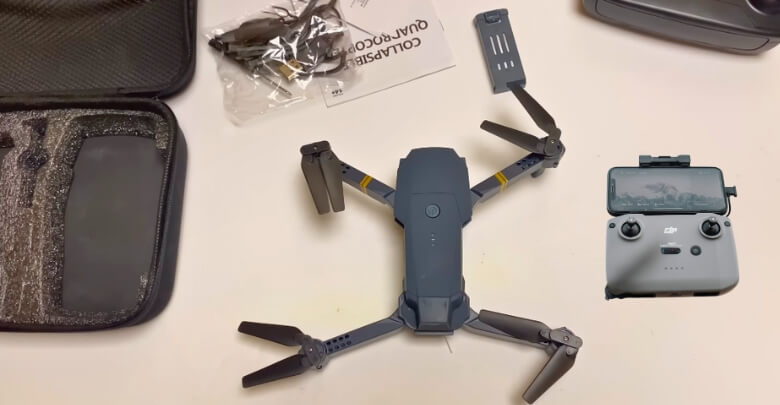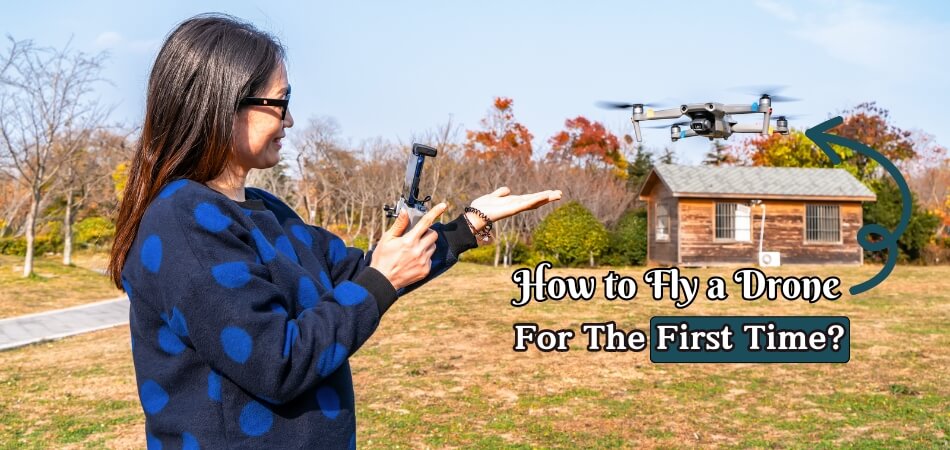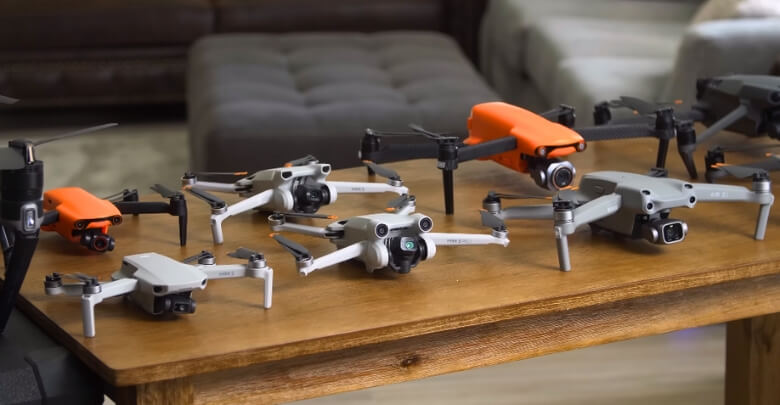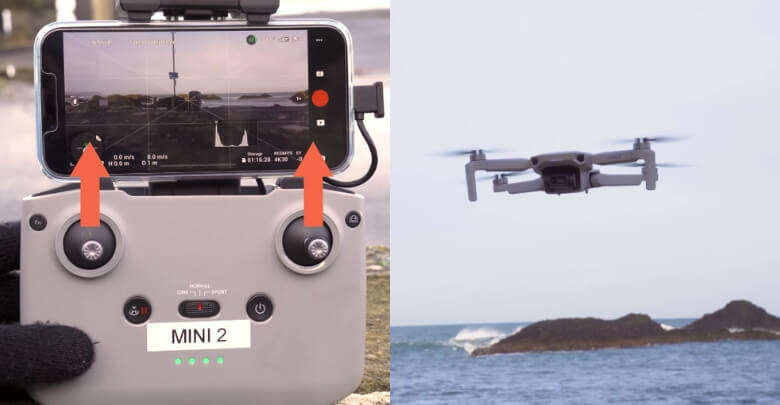The Tactic Air Drone welcomes you to the world of aerial exploration! Are you ready to explore the skies in an exhilarating way? We will guide you through the essential steps of mastering how to fly a drone for the first time.
Start in an open area, away from people and obstacles. Read the manual thoroughly. Practice basic maneuvers like takeoff, landing, and hovering. Keep it low and slow at first. Get comfortable with the controls before attempting complex maneuvers. Follow all local regulations and safety guidelines.
Get ready to elevate your perspective with our comprehensive guide. Join us as we explore the exciting world of drone flying!
How to Setup a Drone?
Drone setup requires attention to detail and adherence to manufacturer instructions. You can ensure a smooth and safe setup process by following these steps. Here Tactic Air Drone is taken as an example.

Unboxing and Inspection
Begin by carefully unboxing your drone and inspecting all components for any signs of damage or defects. Ensure that you have all necessary parts including the drone itself, remote controller, batteries, propellers, and accessories.
Charging Batteries
Charge the batteries for both the drone and the remote controller using the provided chargers. Make sure to follow the manufacturer’s instructions regarding charging times and procedures to prevent damage to the batteries.
Assembling the Drone
Assemble the drone by attaching the propellers securely to the designated arms, ensuring they are properly aligned and tightened. Connect the battery to the drone and ensure it is securely in place.
Controller Setup
Power on the remote controller and ensure it is fully charged. Follow the instructions in the drone’s manual to pair the controller with the drone, usually done by pressing specific buttons or toggling switches.
Firmware Updates
Check if there are any firmware updates available for your drone and remote controller. Download and install these updates following the manufacturer’s instructions to ensure optimal performance and functionality.
Calibration
Perform calibration procedures as outlined in the drone’s manual. This typically involves placing the drone on a flat surface and following on-screen prompts or controller inputs to calibrate the gyroscopes and sensors.
Safety Checks
Before flying, conduct thorough safety checks such as ensuring the propellers are securely attached, no obstructions are present, and the battery is properly connected and charged. Check the weather conditions and choose a suitable flying location.
Test Flight
Take your drone to an open, clear area away from obstacles and people. Gradually increase the throttle and familiarize yourself with the controls. Practice basic maneuvers such as takeoff, hovering, forward/backward flight, and landing.
Practice and Enjoy
With the basics mastered, continue practicing flying your drone in different conditions and environments to improve your skills. Remember to always fly safely and responsibly, adhering to local regulations and guidelines. Enjoy exploring the world from a new perspective with your drone!
How to Fly a Drone for The First Time?
Getting ready to take off with the Tactic Air Drone? Maybe you’re wondering if flying a drone is hard. Take off smoothly and guide the sky with confidence by following these steps.

Preparation
Before flying your Tactic Air Drone, familiarize yourself with its manual. Charge the batteries fully and ensure all components are in working order. Find an open area away from obstacles and people.
Safety First
Always prioritize safety. Inspect your surroundings for potential hazards like trees, power lines, or buildings. Ensure your drone is within your line of sight at all times to avoid accidents.
Calibration
Calibrate your drone according to the manufacturer’s instructions. This ensures stable flight and accurate piloting. Follow the calibration process meticulously to prevent any issues during flight.
Takeoff
Place your drone on a flat surface. Turn on the remote controller and then power up the drone. Engage the throttle gently to lift off smoothly. Maintain a steady ascent until you reach your desired altitude.
Basic Controls
Practice basic maneuvers such as ascending, descending, and hovering. Familiarize yourself with the controller’s sticks for precise control over pitch, roll, yaw, and throttle.
Orientation Awareness
Maintain awareness of your drone’s orientation at all times. Use visual cues such as its front-facing lights or markings to ensure you’re flying in the correct direction.
Flight Modes
Experiment with different flight modes offered by your Tactic Air Drone, such as GPS mode or altitude hold. Each mode provides unique capabilities that suit various flying conditions.
Practice
Start with simple flights, gradually increasing complexity as you gain confidence. Practice smooth movements and gradual turns to master control over your drone.
Emergency Procedures
Be prepared for emergencies. Know how to execute an emergency landing if necessary. Familiarize yourself with the failsafe mechanisms of your drone to mitigate potential risks.
Landing
When it’s time to land, reduce the throttle gradually to descend smoothly. Aim for a spot clear of obstacles and gently bring your drone to the ground. Power off the drone and remote controller safely.
How to Choose the Right Drone for Beginners?
As a beginner, choosing the right drone can be tough. You’ll get a step-by-step guide to guide the process, considering things like purpose, budget, and features, like the Tactic Air Drone.

Assess Your Needs
Consider your primary purpose for using the drone. Are you interested in aerial photography, recreational flying, or racing? Understanding your goals will help narrow down the features you require in a drone.
Research Options
Explore various beginner-friendly drones on the market. Look for models like the Tactic Air Drone that offer easy-to-use controls, stability features, and durability. Read reviews and compare specifications to make an informed decision.
Check Regulations
Familiarize yourself with local drone regulations and restrictions. Ensure that the drone you choose complies with relevant laws regarding registration, flight altitude, and restricted airspace to avoid legal issues.
Budget Consideration
Set a budget for your drone purchase, including additional expenses for accessories like spare batteries and propellers. While cheaper models may lack advanced features, they can still provide an excellent starting point for beginners.
Flight Performance
Pay attention to factors such as flight time, range, and stability. Look for drones with longer battery life and stable flight controls, especially if you’re new to piloting. The Tactic Air Drone offers impressive flight performance suitable for beginners.
Camera Quality
If aerial photography or videography is important to you, prioritize drones with high-quality cameras. Consider features like resolution, stabilization, and the ability to adjust camera settings for better control over your shots.
Ease of Use
Choose a drone with intuitive controls and user-friendly features. Look for models that offer beginner modes or flight assistance functions to help you learn the basics of piloting without risking crashes or accidents.
Portability
Consider the size and weight of the drone, especially if you plan to travel with it. Compact and lightweight models like the Tactic Air Drone are easier to transport and carry, making them ideal for outdoor adventures.
Warranty and Support
Check the manufacturer’s warranty and customer support services offered with the drone. Opt for brands that provide reliable support and easy access to spare parts or repairs in case of any issues or malfunctions.
Personal Preferences
Ultimately, choose a drone that aligns with your personal preferences and priorities. Whether you prioritize advanced features, durability, or affordability, selecting the right drone will enhance your flying experience as a beginner.
Tips for Smooth Flight
Mastering smooth drone flights is essential for capturing stunning aerial footage and enjoying a seamless piloting experience. By following these tips, you can enhance your skills and ensure smoother flights every time.

Understanding Weather Conditions
Before taking off, check weather forecasts to avoid flying in adverse conditions like strong winds, rain, or fog. Windy conditions can affect stability and control, while rain and fog can obscure your vision, increasing the risk of accidents.
Calibrating Your Drone
Ensure your drone is properly calibrated before each flight to maintain stability and accuracy. Follow the manufacturer’s instructions to calibrate the compass, IMU, and gyroscopes, especially when flying in new locations or after firmware updates.
Practicing Smooth Movements
Practice flying your drone with gentle, precise movements to achieve smooth and cinematic footage. Avoid jerky or abrupt maneuvers, as they can result in shaky footage and reduce the overall quality of your aerial shots.
Maintaining Line of Sight
Always keep your drone within your line of sight to maintain control and avoid collisions with obstacles. Flying beyond your line of sight increases the risk of losing connection with the drone and can lead to accidents or loss of the aircraft.
Monitoring Battery Levels
Keep a close eye on your drone’s battery levels during flight and land safely before the battery runs low. Flying with low battery levels can lead to sudden power loss and potential crashes, endangering both your drone and surroundings.
FAQs for How to Fly a Drone for The First Time?
It’s exciting and daunting to fly a drone for the first time. Here are a few common questions beginners have along with detailed answers to help you get started.
Do I Need to Register My Drone?
Depending on your country’s regulations, you may need to register your drone before flying it. Check with your local aviation authority to determine the specific requirements for registration.
What Are Some Basic Safety Precautions I Should Take?
Always fly your drone in an open area away from people, buildings, and other obstacles. Start with low-altitude flights until you’re comfortable with the controls, and never fly in adverse weather conditions.
How Do I Calibrate My Drone?
Most drones require calibration before flight. Follow the instructions in the manual to calibrate the compass and IMU (Inertial Measurement Unit) to ensure accurate flight performance.
What Should I Do if My Drone Loses Connection with The Controller?
If your drone loses connection with the controller, remain calm and avoid panicking. Try to regain control by moving closer to the drone or activating the return-to-home feature if available.
How Can I Extend the Battery Life of My Drone?
To extend your drone’s battery life, avoid aggressive maneuvers and fly in optimal weather conditions. Monitor the battery level throughout your flight and land the drone safely before the battery becomes critically low.
What Should I Do if My Drone Crashes?
If your drone crashes, assess the damage before attempting to fly it again. Inspect the propellers, motors, and frame for any signs of damage, and recalibrate the drone if necessary.
Final Thought
It’s important to prepare meticulously and commit to safety before starting your drone-flying journey. Choosing the right drone and mastering basic controls are key to a smooth and enjoyable experience. Invest in proper training and equipment, familiarize yourself with local regulations, and prioritize safety.
Start in an open area, practice basic maneuvers, and gradually increase complexity as you take to the skies for the first time. Whether you’re flying the Tactic Air Drone or another model, exploration awaits.
Don’t be afraid to dive in and discover the wonders of aerial perspective. How to Fly a Drone for the First Time? This isn’t just a question, it’s an invitation to take flight and elevate your perspective.






